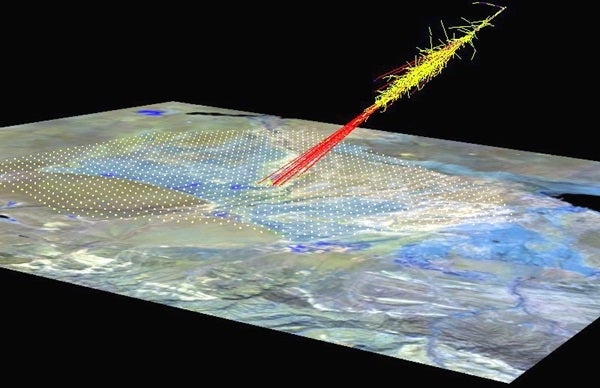Astrophysicists using a radio antenna array have detected radio flashes associated with ultrahigh-energy cosmic rays (UHECRs). These flashes are the brightest and fastest radio flashes ever seen in the sky, and this marks the first time radio flashes associated with UHECRs have been imaged. The international group’s findings were published in the May 19 issue of Nature.
By combining data from both radio and particle detectors, astrophysicists expect to learn more about the nature and composition of UHECRs — cosmic rays with energies above 1020 eV — which remain a mystery.
Cosmic rays are high-energy particles that bombard Earth at a rate of about 1 particle per centimeter-squared each second. These particles — the “primary” cosmic rays — are mostly protons, but also can be heavier nuclei or electrons. (UHECRs could be “less common” particles.) When the primary cosmic rays collide with atoms in the atmosphere they produce showers of particles called “secondary” cosmic rays. These secondaries are mostly pi-mesons — neutral and charged pions. The neutral pions decay into pairs of gamma rays, which may create an electron and a positron. The charged pions eventually decay into muons and muon neutrinos.
These particles hit Earth’s surface and are detected by particle experiments. Cosmic-ray detectors also measure these particles’ energies, and therefore can calculate the primary particle’s energy.
As electrons and positrons speed through the atmosphere, they are deflected by Earth’s magnetic field. This process gives off synchrotron radiation — as the electron changes direction something must be emitted to conserve momentum — with some of this radiation in the radio end of the electromagnetic spectrum.
LOPES detected radio pulses that were coincident with the direction of shower particles. The astrophysicists write in their Nature paper: “The close association between radio flashes and cosmic ray air showers in direction and time shows that the radio emission is directly associated with the shower itself.”










